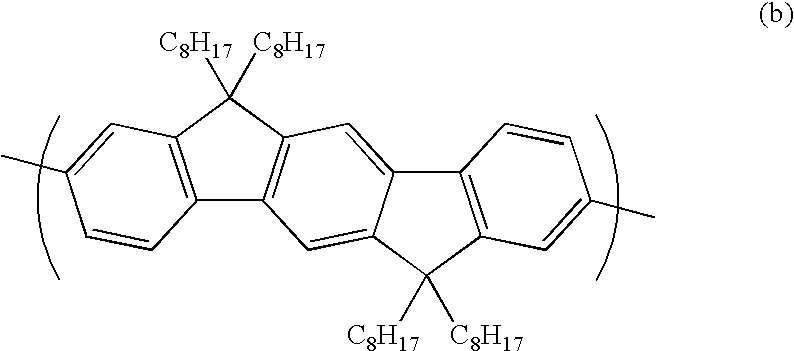Polymers for Use in Organic Electroluminescent Devices
- Summary
- Abstract
- Description
- Claims
- Application Information
AI Technical Summary
Benefits of technology
Problems solved by technology
Method used
Image
Examples
examples
1. Procedures for the Synthesis of Monomer 1
[0117] The overall synthetic sequence for the synthesis of Monomer 1 is as follows
[0118] The individual steps in the above synthetic sequence are described below.
2-lodo-5-bromo-1-benzoic Acid (2)
[0119] To a 100 mL round bottom flask was added 5-bromo-2-iodotoluene (1) (10.0 g, 33:7 mmol, 1.0 eq.), pyridine (100 mL), deionised water (10 mL) and potassium permanganate (13.31 g, 84.3 mmol, 2.5 eq.). The flask was fitted with a reflux condenser, mechanical overhead stirrer and nitrogen inlet / exhaust. The mixture was heated to reflux under nitrogen (oil bath 100° C.). After 5 hours at reflux, thin layer chromatography (TLC) indicated some starting material remained, so a further 1.3 eq. of potassium permanganate was added and the mixture allowed to reflux for a further 16 hours. TLC after this time indicated some starting material remained, so a further 1.3 eq. of permanganate was added and the temperature of the oil bath raised to 110° ...
PUM
| Property | Measurement | Unit |
|---|---|---|
| Magnetic field | aaaaa | aaaaa |
| Dynamic viscosity | aaaaa | aaaaa |
Abstract
Description
Claims
Application Information
 Login to View More
Login to View More - R&D
- Intellectual Property
- Life Sciences
- Materials
- Tech Scout
- Unparalleled Data Quality
- Higher Quality Content
- 60% Fewer Hallucinations
Browse by: Latest US Patents, China's latest patents, Technical Efficacy Thesaurus, Application Domain, Technology Topic, Popular Technical Reports.
© 2025 PatSnap. All rights reserved.Legal|Privacy policy|Modern Slavery Act Transparency Statement|Sitemap|About US| Contact US: help@patsnap.com



